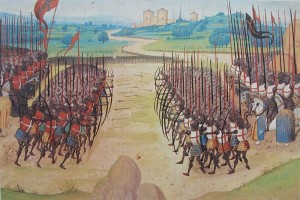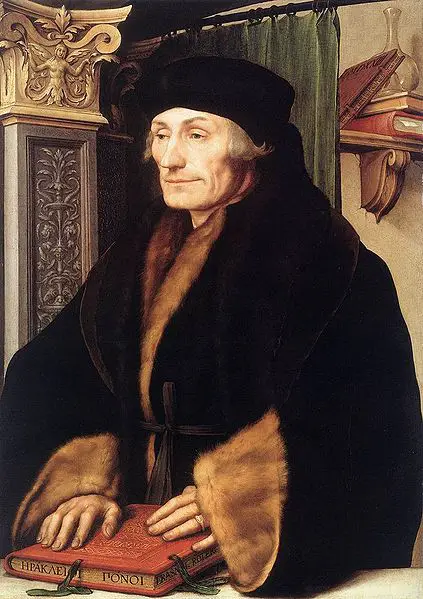
Battle of Agincourt, miniature taken from l’Abrégé de la Chronique d'Enguerrand de Monstrelet, XVe siècle, Paris.
Today, Heather Darsie shares an article with us on the Battle of Agincourt back in 1415.
The 100 Years' War
This day is called the Feast of St. Crispian.
25 October 2015 marks the 600th anniversary of the Battle of Agincourt. The Battle of Agincourt was one of a number of battles fought during the 100 Years' War, which began in approximately 1337 and formally ended in about 1453. The 100 Years' War was fought over a struggle for English territory in French lands and also the throne of France. Due to the Norman Conquest of 1066, marriage alliances and the rights of inheritance, the titles England held in France were altered not infrequently.
In 1411, civil war broke out in France between the Burgundian and Armagnac factions. Due to the Charles VI, King of France's poor health, the king's brother, Louis d’Orléans, struggled with the king's cousin, John the Fearless, who was duke of Burgundy. After Louis d'Orléans was murdered in 1407, the father-in-law of Louis' son, Bernard VII, count of Armagnac, took up the cause against the Burgundian faction.
Henry V ascended to the English throne in 1413. With the French still fighting amongst themselves, Henry V chose to assert his claim to the French throne. The two countries attempted to negotiate a settlement, with Henry V increasing his demands and the French quickly shooting them down. In the winter of 1414 to 1415, Henry V ordered his officers to prepare to cross the Channel from Southampton. English forces landed in France in August of 1415 and quickly attacked the town of Harfleur. After a long siege with stubborn resistance, Harfleur finally surrendered on 22 September 1415. Little time was left in the campaigning season and the French were converging.
Henry V of England and Charles VI of France
He that outlives this day, and comes safe home, will stand a tip-toe when this day is nam'd, and rouse him at the name of Crispian.In August 1387, Henry V of England was born at Monmouth, in present-day Wales. When he was about eleven years old, Henry's father was exiled and Richard II took the young Henry under his wing. By 1400, Wales was being administered in Henry's name. By 1403, Henry was in control of the English forces. Henry continued to gain power and obtain more and more influence at court, until he was dismissed from the council in 1411. In 1413, when Henry was not quite twenty-six years old, he ascended the throne as Henry V. One of Henry's main preoccupations at the beginning of his reign was to revive English prestige in Europe.
With several years' experience in diplomacy and military exercises already behind him, Henry quickly quelled any domestic threats and turned his attention to foreign affairs by 1415. After chasing the Genoese allies of France out of the Channel, Henry was able to launch his campaign in France. That campaign culminated in the stunning victory at Agincourt. From the very start, Henry was an ambitious, cunning, powerful king.
Charles VI of France, known as the Mad King, was born in December 1368. He became king of France in 1380 and took full control of the throne by 1388. As a young man, Charles was handsome, charming, and successful in both military efforts and tournaments. As the future king, the young Charles seemed promising. He married Isabeau of Bavaria in 1385, three years before taking full control of the French throne. At the very beginning, his rule was successful and Charles set about reorganizing the government and helping to establish the Antipope Clement VII as the pope in Rome, though this latter diplomatic endeavor never came to fruition and Antipope Clement VII passed away at Avignon in 1394.Approximately four years into his full reign, Charles suffered his first fit. This marked the beginning of his mental illness, which is thought to be paranoid schizophrenia. On that fateful day of August, 1392, Charles and his party were hunting down a fugitive when an unknown man grabbed the bridle of Charles's horse and declared Charles's doom. The party carried on a way, but the clattering of a lance on the ground caused Charles to lash out and kill a few knights and a nobleman in the party. Charles would go on to have forty-four fits of madness in his lifetime, with each lasting several months. He sometimes did not recognize family members, would run about the castle howling like a wolf, and even occasionally believed he was made of glass and thus, incredibly fragile. Charles VI had been mad for thirteen years by the time the Battle of Agincourt came to pass.
The Armies
He that shall outlive this day, and see old age, will yearly on the vigil feast his neighbours, and say, 'Tomorrow is St. Crispian.'
Already wearied from the siege of Harfluer, Henry V's roughly 5,000 strong Welsh and English army turned its attention to Calais. Calais lies 100 miles away from Harfleur, Henry's army was weak, and the Armagnac and Burgundian factions had loosely come together to repel this foreign invasion, despite the ongoing struggle for control of the French realm under Charles VI, the Mad King. Henry and his army came upon the Somme estuary, where the French prevented them from crossing. The English made several more attempts and were finally able to cross. The French forces were amassing and threatening the English. Henry ordered his army and remaining archers to prepare for a mounted attack.
The English had left Harfleur in early October and had been marching for over two weeks by the time St. Crispin's Day arrived. The archers carried longbows and had little to no armour. Most of the English army wore shoes, if they had them, hose, jackets, and skull caps. Beyond their longbows, they carried daggers, hatchets, swords, war hammers and other weaponry designed for close-range combat.
By comparison, the French armies were enormous and very well protected. Although the exact number of troops is unknown, just like with the English army, there were at least 30,000 French and may have been as many as 100,000 French. Several of the knights were mounted and heavily armored. They wore thick steel plate and helmets with visors. For the battle, the knights wielded lances, one-handed swords and two-handed swords.
Setting
Then will he strip his sleeve and show his scars and say 'These wounds I had on Crispin’s day.'
The battlefield was situated near the little town of Hesdin, by present-day Azincourt. From rain the night before and recent plowing, the field itself was quite muddy. The field was flanked on either side by woodlands, which also could affect the mobility of an army. Henry V's archers planted sharp, wooden stakes in the ground in front of them to deflect the cavalry and knights. Overall, the battlefield was narrow and difficult for the heavily-armed French army to navigate.
The English Longbow
We few, we happy few, we band of brothers...
The English longbow, or war bow, is what won the day for Henry V at the Battle of Agincourt. War bows were recently recovered from Henry VIII's ship the Mary Rose. War bows were six to seven feet tall and constructed of yew. The wood from a yew tree had a good balance of sapwood, the flexible part of a tree found just under the bark, and heartwood, the compression-resistant center of a tree. When strung, the heartwood comprised the belly of the bow, or part that faces the archer, where the sapwood was on the back of the bow, which faces away from the archer. Sometimes, the backs of the bows still had bark on them. The ends were reinforced with nocks made of horn.
The bows could shoot up to two hundred and fifty yards, with bows designed in the 1500s being able to shoot up to four hundred yards. The bolts used were up to three feet long and could pierce armor. The draw weight on these bows was enormous, and could be upwards of one hundred pounds. Interestingly, these bows were pushed and not pulled. What this means is, instead of an archer holding the bow in the left hand and using the right hand to draw back the bow-string, the archer would hold the bow-string in the right hand and, using strength and body weight, push the bow forward. This may account for why the English were able to make use of such impressive draw weights. The range of the war bows and bolts used allowed the English to do a lot of damage with a smaller army.
The Battle and its Impact
... He to-day that sheds his blood with me shall be my brother; ... That fought with us upon Saint Crispin’s day.
Three hours after sunrise on 25 October 1415, Henry V's army taunted the French, who had many different leaders and were arranged in three lines. The French army marched forward, but the heavily-armed knights quickly became bogged down and fatigued by their progress through the mud, which was described as being knee-deep in some parts. As the French continued their march, the battlefield narrowed and made it difficult, if not impossible, for them to draw and wield their one- and two-handed swords. Some of the knights who fell down could not get back up and actually drowned in their helmets. Coming behind the armored knights were the French archers and crossbowmen, who made very little impact on the battle due to their position at the very back of the lines. Despite these obstacles, the French did initially manage to push back the English.
The English army was fatigued from the march north to Calais, previous battles, illness and hunger. But the English archers, equipped with war bows, were protected by the forest and sharpened wooden stakes. When the small, disorganized French cavalry charged forward, they were unable to do any meaningful damage to the English archers because of the aforementioned obstacles. The wounded horses ran back through the French lines and injured or trampled some members of the French infantry.
The French infantry crept closer and closer. The English unleashed a hail of arrows, which eventually pierced the wrought iron armor of the French. The French who wore plate armor were protected for a bit longer, but eventually, were susceptible to the English arrows. Complicating things further for the French, the visors of their helmets had to be pulled down for protection against the arrows, which made it difficult for the infantry to breathe or see.
By the time the surviving French actually came upon the English line, they were exhausted by dragging through the clay-rich mud in armour that weighed fifty to sixty pounds. The very lightly armored English were able to make quick work of them. Although the exact number of French and English casualties is unknown, it is agreed that the English were vastly outnumbered by the French. After his victory, Henry V summoned the French and English heralds to name the battle, and settled on naming the battle after the nearest fortification, which was then known as Agincourt.
As a result of Henry V's victory, he married Charles VI's daughter Catherine of Valois. This meant that Henry's son and heir, Henry VI, was eligible to inherit the thrones of both England and France. Henry V and the Battle of Agincourt serves as an example and reminder of the courage of the English people, firing the pride and imagination of Henry VIII over one hundred years later. The Battle of Agincourt reinforced the English claim to the French throne, which Henry VIII sought to obtain throughout his reign.
A hidden chapel built for King Henry V is opening to the public for the first time to mark the 600th Anniversary of the battle of Agincourt - click here for more on this.
Heather R. Darsie lives in the United States with her family and three parrots. She works in the legal field, with a focus on children. She obtained a Bachelor of Arts degree in German Languages and Literature, then a Juris Doctorate in American jurisprudence, and studied abroad in Costa Rica and France. Heather has always loved history. She first became acquainted with Elizabeth I when she was in middle school and chose to write a book report about her. Since then, she has always held an interest in the Renaissance and its numerous enigmatic citizens, with particular focus on the history of England and Italy. She is currently working on a book on the heraldry of Tudor women and is also researching Anne of Cleves.
Sources and Suggested Reading
- Shakespeare, William. Henry V. Act 4, Scene 3, excerpt from lines 18-67.
- British Battles. “The Battle of Agincourt.” http://www.britishbattles.com/100-years-war/agincourt.htm Retrieved 20 October 2015.
- Editors of the Encyclopedia Britannica. “Hundred Years’ War.” http://www.britannica.com/event/Hundred-Years-War Retrieved 22 October 2015.
- Editors of the Encyclopedia Britannica. “Charles VI, King of France.” http://www.britannica.com/biography/Charles-VI-king-of-France Retrieved 18 October 2015.
- Ross, C. D. “Henry V, King of England.” http://www.britannica.com/biography/Henry-V-king-of-England Retrieved 18 October 2015.
- Kingsford, C. L. “Henry V. King of England (1387-1422).” Excerpted from Encyclopedia Britannica, 11th Ed. Vol XIII. Cambridge: Cambridge University Press, 1910. 278. http://www.luminarium.org/encyclopedia/henry5.htm Retrieved 18 October 2015.
- George L. Williams, Papal Genealogy: The Families and Descendants of the Popes, (McFarland & Company Inc., 1998).
- The Columbia Electronic Encyclopedia™ Copyright © 2013, Columbia University Press. Licensed from Columbia University Press. All rights reserved. “Armagnacs and Burgundians.” http://encyclopedia2.thefreedictionary.com/Armagnacs+and+Burgundians Retrieved 21 October 2015.
- Vitelli, Romeo. “The Glass King.” December 28, 2010. http://drvitelli.typepad.com/providentia/2010/12/the-glass-king.html Retrieved 22 October 2015.
- Rough Guides. “Crécy and Agincourt Battlefields.” http://www.roughguides.com/destinations/europe/france/north/cr%C3%A9cy-agincourt-battlefields/ Retrieved 20 October 2015.
- EyeWitness to History. "The Battle of Agincourt, 1415. (2006). http://www.eyewitnesstohistory.com/agincourt.htm Retrieved 21 October 2015.
- English Warbow Society. “The English War Bow.” http://www.theenglishwarbowsociety.com/warbow_EN.html Retrieved 20 October 2015.
- Haigh, Christopher, Ed. The Cambridge historical encyclopedia of Great Britain and Ireland, (Cambridge University Press, 2000.
- Wavrin, Jehan de, trans. Sir W. Hardy and E. Hardy. Chronicles, 1399-1422. (1887).
- Keegan, John. The Illustrated Face of Battle: a study of Agincourt, Waterloo and the Somme. (1989).





Leave a Reply